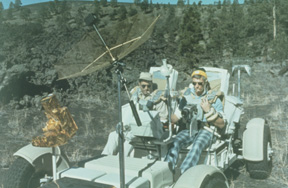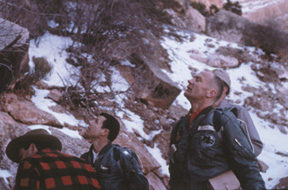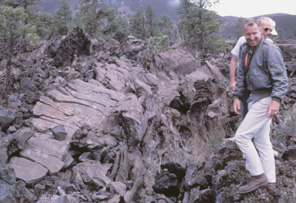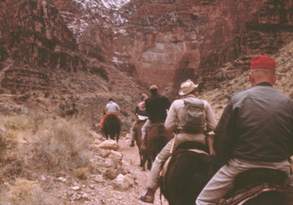geotimesheader
Feature
The
Making of Lunar Explorers
by Peter
Margolin
It was 1961, and John F. Kennedy
challenged the nation to reach the moon before the end of the decade. Would
America simply go there and return, just to show the world we could beat
the Russians? Or would we use the chance to explore Earth’s neighbor and
learn something about its composition, history and origin? Twelve U.S.
astronauts walked on the moon between July 1969 and December 1972.
Only one was a scientist.
On Aug. 1, 1971, astronauts David Scott
and James Irwin were exploring the Apennine Mountains on the moon, a few
kilometers from their Apollo 15 landing site. They weren’t geologists,
but they had received seven years of training from geologists, so they
knew what kinds of rocks they would find on the moon. Scott noticed a rock
characterized by large, shiny crystal faces and parallel striations — what
he thought were signs of plagioclase. He told Mission Control in Houston
he thought the rock might be composed entirely of plagioclase, and remembered
from his training that this was the definition of anorthosite. He was right.
What Scott found boosted geologists’ hunch that the oldest lunar crust
consisted largely of anorthosite. Elated by Scott’s discovery, news reporters
back at Houston promptly dubbed his find “Genesis Rock.” |

Above: Apollo 17
astronauts
Jack Schmitt (left) and Ron Evans
(right) training in
the Lunar Rover Vehicle mock-up at Sunset
Crater, Ariz., June
1972. All photos courtesy of Don Wilhelms. |
Scott was one of 12 astronauts who brought back almost 850 pounds of
rock and soil from the moon during the six moon landings. Analyses of these
samples revealed the chemistry of the lunar crust and showed that it contained
lower concentrations of silicon and volatile elements and higher concentrations
of titanium than Earth’s crust. Some of the samples were also enriched
in a unique suite: potassium, phosphorous, certain rare-earth elements,
uranium and thorium.
Working with these facts, in 1975 astronomer William Hartmann of the
University of Arizona suggested a solution to the mystery of the moon’s
origin. Characterized by some as the Big Whack, Hartmann’s theory was that
the impact of a Mars-sized planetesimal with Earth about 4.5 billion years
ago lofted enough debris into Earth orbit to coalesce and form the moon.
By 1985, this had become the most widely accepted theory of the moon’s
origin. Today, it rests solidly on a foundation built by 11 test pilots
and a geologist.
In 1962, charged with carrying out the mission President Kennedy had
envisioned, NASA decided it made better sense to teach test pilots the
rudiments of geology than to expect geologists to learn to fly rockets.
Thus it turned to the nation’s preeminent earth-science organization, the
U.S. Geological Survey (USGS), to provide geologic training for astronauts
bound for the moon. NASA money had begun flowing into the survey two years
before, when $200,000 was allotted for an infant lunar studies program
that included investigating tektites and mapping the moon photogeologically.
Geology
101: Flagstaff
The astronauts got their introduction to geology with a flight over
Flagstaff, Ariz., in January 1963. Observing Flagstaff’s many examples
of Pleistocene and recent volcanism, they peered down into the pristine
bowl of cinder cones such as Sunset Crater, which had erupted only 900
years before. Geology seemed to agree with them, especially from the air.
In 1948, when Eugene Shoemaker decided he wanted to be the first geologist
to land on the moon, he took his first steps in the Flagstaff area. (Shoemaker,
who died in a car crash in 1997, didn’t make it to the moon in his lifetime.
His ashes were made to crash land on the moon last year aboard the Lunar
Orbiter.) Working as a USGS geologist in the 1950s, he showed how Meteor
Crater had formed by the impact of a meteorite, and he estimated the size,
mass and terminal velocity of the impacting object. The crater thus became
the first scientifically documented structure of its kind. At Hopi Buttes,
a Miocene-Pliocene volcanic field of more than 300 eruptive centers, he
studied maars and diatremes as possible examples of explosive lunar volcanism.

Apollo 11
astronaut Buzz Aldrin at a view point along the
Bright Angel Trail,
Grand Canyon, in 1964. |
Classroom training of the Apollo astronauts started in 1964 at the
Manned Spacecraft Center in Houston. Thirty astronauts had been selected
for the Apollo program, including Alan Shepard, America’s first man in
space; John Glenn, first to orbit Earth; and Gemini veteran Neil Armstrong.
USGS geologists Dale Jackson, Al Chidester, Don Wilhelms, Dan Milton and
Gordon Swann introduced 29 test pilot astronauts to basic geologic concepts
and the mechanics of impact cratering. NASA geologists gave lectures on
how to recognize different types of rocks and minerals.
But Jackson realized there was only so much textbook geology that a
test pilot could stomach, so in March 1964 he organized the first of an
extensive series of field trips to use Earth as a laboratory for the moon.
He took the astronauts to the Grand Canyon, where outcrops illustrate basic
stratigraphic principles in ways more memorable than any textbook. |
From 1964 to 1969, geologists took the astronauts to places where the
rocks and structures displayed effects of either volcanism or impact mechanics.
Guiding the astronauts were Howard Wilshire and Dave Roddy, who both studied
the geology of ancient impact structures (astroblemes); Don Wilhelms, who
devoted his career to photogeologic study of the moon; and others who studied
the diatremes and maars thought to resemble lunar eruptive vents.
By the summer of 1969, weeks before the Apollo 11 landing, the
training intensified. USGS geologists began giving astronaut crews highly
detailed briefings on the terrain and geology they should expect at their
assigned landing sites. Command module pilots also received instruction,
organized by the survey’s Harold Mosursky and by Bellcomm geologist Farouk
El-Baz, an expert on remote sensing and now director of the Center for
Remote Sensing at Boston University. For the several days these pilots
would orbit the moon, waiting for their moon-walking partners to return,
they could take photographs and scout lunar terrain for tell-tale geologic
clues. Such scouting by Apollo 15 command module pilot Alfred Worden
in July 1971 provided information for selecting the last of the landing
sites, the one targeted for Apollo 17 Commander Eugene Cernan and
geologist-astronaut Jack Schmitt. While in orbit, Worden photographed dark-rimmed
craters that geologists had told him were prime candidates in the hunt
for evidence of explosive volcanism.
Dress rehearsals
for the moon
As part of the intensified training, moon-like areas on Earth were the
stage for dress rehearsals. The setting that most nearly duplicated lunar
terrain was a replica prepared in a field of black volcanic cinders called
Cinder Lake, a few miles northeast of Flagstaff, Ariz., within the ashfall
from Sunset Crater’s last eruption.
At Cinder Lake, astronauts walked across craters of the same size, shape
and position as those in a particular section of lunar terrain photographed
a few years earlier by a robot space probe, Lunar Orbiter. By the
summer of 1970, they were touring these crater replicas in a mockup of
the 450-pound electric go-cart, the Lunar Roving Vehicle, that would
be used on the three final moon landings. They maintained radio contact
with a mock-up mission control in Flagstaff, where geologists monitored
the astronauts’ progress, answered their questions and asked for clarifications
as the astronauts described what they saw.
| Geologists devised an ingenious design for the Cinder Lake training
ground. First, explosive charges were buried in a pattern corresponding,
on a one-to-one scale, to that visible in high-resolution photos of a section
of the moon’s dark, flat plains, the maria. The size of each charge was
adjusted so that the explosion would produce a crater roughly the same
size as its lunar counterpart. But geologists also wanted to duplicate
two basic aspects of lunar impact craters. For thorough realism, ejecta
from newer craters had to overlap ejecta from older ones, and the site
needed a continuum of crater “freshness,” with the youngest having the
sharpest, most distinct features. Rather than set off all the charges at
once, the oldest, most eroded craters (eroded on the moon by micrometeorite
bombardment and other cratering processes) were blasted out first, with
succeeding series of explosions producing younger, fresher craters. |

Apollo 8
and
Apollo
13 astronaut Jim Lovell at a lava squeeze-
up near Sunset
Crater, Arizona, in May 1964. |
These dress rehearsals continued after the first moon landing, as did
field trips to major astroblemes. The astronauts familiarized themselves
with impact breccias at the Sierra Madera uplift near Fort Davis, Texas.
At this astrobleme, they could also see the cone-in-cone structures (shatter
cones) characteristic of sedimentary rocks subjected to hypervelocity impact.
An August 1970 trip to the Ries Crater (Rieskessel) in Bavaria gave astronauts
Alan Shepard and Edgar Mitchell a chance to see what impact breccias might
look like on Earth — a year before they would find the lunar equivalents
while exploring the south flank of Cone Crater at the Apollo 14
landing site.
As early as 1946, Robert Dietz had called attention to the nickel-bearing
Sudbury structure in Ontario as a feature that could have been formed by
meteorite impact in Proterozoic time. In July 1971, astronauts John Young
and Charles Duke got their first look at Sudbury’s ancient impact breccias
in
situ. Eight months later, they would sample lunar rocks of this origin
in the vicinity of their Apollo 16 landing site, thus demolishing
geolgists’ idea that the bright lunar highlands were scenes of significant
volcanic activity.

Apollo
11 astronaut Neil Armstrong, on mule, follows USGS
geologist
Don Wilhelms along the Bright Angel Trail, Grand
Canyon,
May 1964. |
The astronauts also studied man-made craters, including the huge craters
produced by underground nuclear explosions at the Nevada Test Site. These
craters displayed features resembling those at Meteor Crater, such as overturned
beds on crater rims. The missile-impact craters that geologist Henry Moore
and Peter Margolin studied in 1967 and 1968 at New Mexico’s White Sands
Missile Range helped the astronauts recognize particular impact features
and to collect samples of ejecta.
Field trips also showed the astronauts plutonic rocks in a natural context.
Anorthosite inspired a visit to Minnesota’s Duluth Complex in 1970 and
a tour of California’s San Gabriel Mountains. The first hint that this
terrestrially uncommon rock type might be widespread on the moon was found
in lunar soil Neil Armstrong and Edwin “Buzz” Aldrin returned in 1969. |
Recipes
for success
Jack Scmitt was the sole geologist in the Apollo missions and rode with
Gene Cernan in the Apollo 17 mission. But the Apollo program’s first
and only geologist to go to the moon experienced his measure of disappointment.
In December 1972, on his second excursion from the Apollo 17 landing
site, he found what looked like orange volcanic ash on the rim of a crater
named Shorty in the valley Taurus-Luttrow. He thought he had discovered
a true volcanic vent in the crater. But, noticing the crater’s blocky ejecta,
he soon began doubting this conclusion. The ash, although genuinely volcanic,
turned out to be billions of years old, far older than the crater at which
it was found.
How had the nonscientists who flew Apollo 15 and Apollo 16
reaped such major scientific rewards? For one thing, they had a longer
training period than did the astronauts of earlier landings. For another,
the Apollo 15 landing vehicle had been upgraded to support a three-day
stay. The couple of hours Armstrong and Aldrin spent outside of their Apollo
11 landing vehicle were barely enough for grabbing 50 pounds of material
before heading home. On later missions, the astronauts had more time to
judge which materials were of geologic interest and worth bringing home.
And improved tracking methods let Earth-bound geologists follow the explorers
from moment to moment, with no uncertainty about precisely where the samples
were being collected.
The Apollo 15 pair, Scott and Irwin, were lucky in their landing
site assignment. Situated on a mare plain at the foot of the Apennine Mountains,
this site was the only one near the edge of a sinuous rille, Rima Hadley,
longest of the moon’s winding canyons apparently produced by swiftly moving,
highly fluid lava. Visible in the canyon walls were layers of basaltic
bedrock, the only such layers any of the astronauts would see on the moon.
As a result, samples of basalt that Scott and Irwin collected near the
edge of the rille were closer to being in situ than any others brought
back to Earth (the anorthosite that Scott collected was interpreted as
talus, carried by downslope movement from the bedrock core of the mountain).
The scientific achievements of the Apollo 15 and Apollo 16
missions grew from seven years of geologic training and a rare combination
of skill, determination and luck.
Margolin worked at the U.S. Geological
Center for Astrogeology in Flagstaff, Ariz., from 1966 to 1969. Semi-retired
now, he pursues his mineralogical interests working summers as a Park Ranger
at the Blue Ridge Parkway’s Museum of North Carolina Minerals, while researching
prehistoric mica mining and soapstone quarries near his home in the mountains.
| Searching
for impact craters
When Eugene Shoemaker decided to use the
geology around Flagstaff, Ariz., as a stage for lunar geology, he was following
the lead set 60 years before by USGS geologist Grove Karl Gilbert. Gilbert
became interested in the moon and its craters near the end of the 19th
century, two decades after his classic study of Utah’s Henry Mountains.
In 1891, he ran magnetometer surveys across Meteor Crater, then called
Coon Butte, hoping to locate a buried meteorite and prove the unearthly
origin of the crater. Finding no such mass, he reluctantly concluded the
crater was produced by exploding volcanic steam. The USGS found no reason
to question this conclusion until Eugene Shoemaker explained the absence
of a buried meteorite in his authoritative study of the origin of Meteor
Crater. (The meteorite had exploded and disintegrated upon impact.)
Believing he had failed to locate a meteorite
crater on Earth, Gilbert trained his sights directly on the moon, spending
weeks looking at it through the telescope of the Naval Observatory in Washington.
For this he took flak from a congressman,
who reportedly said that the uselessness of the USGS was evident in that
“one of its most distinguished members has no better way to employ his
time than to sit up all night gaping at the Moon.” Gilbert’s “gaping” produced
the first modern geologic observations of the moon, a paper entitled
“The Moon’s Face,” in which he deduced an impact origin for most lunar
surface features, large and small, while considering volcanic activity
responsible for some of the smaller, Earth-scale craters. The latter he
thought might turn out to resemble terrestrial landforms such as maars
and calderas, produced by explosive volcanism and collapse.
Peter Margolin
|




